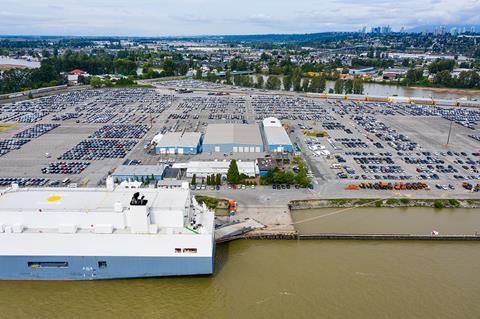[Updated November 13] A lockout of workers by the British Columbia Maritime Employers Association (BCMEA) following threatened strike action by the International Longshore and Warehouse Union (ILWU), which was affecting cargo throughput at the Canadian port of Vancouver, has ended following intervention by Canada’s labour minister. Steven MacKinnon has used federal powers to end work stoppages at the port, ordering binding and final arbitration between labour unions and ports ownership.
The same powers have been used to end stoppages at Prince Rupert port and at the port of Montreal. MacKinnon instructed the Canada Industrial Relations Board (CIRB) to end the strikes because mounting economic losses required urgent action to protect jobs and Canada’s economic stability.
At Vancouver, which is Canada’s biggest vehicle-handling port, he lockout began at 08.00 on November 4. The Vancouver Frasier Port Authority said the dispute, which is in part about manning and automation, affected BCMEA member terminals, where 730 members of the ILWU and Dock Foremen Local 514 are employed.
A record of almost 250,000 vehicles were handled by the port’s auto terminals in the first half of 2024, which includes the Annacis Auto Terminal where an optimisation project by the port authority and Wilhelmsen Port Services has helped increase capacity by more than one-third. Wallenius Wilhelmsen Solutions moves vehicles through the terminal and has been working with the port authority to consolidate automobile operations at the expanded Annacis terminal and repurpose the Richard Auto Terminal.

Nearly 100% of Canada’s Asian-manufactured vehicle imports come through the port of Vancouver.
There has been limited anchorage capacity at the port because of the elevated seasonal demand in the bulk sector, with grain exports at their peak period. Grain and cruise operations, along with operations at the Westshore coal terminal are expected to continue but other commodities, including finished vehicles, have been affected for a week.
“We are working closely with the industry to optimise anchorage utilisation to ensure port fluidity by prioritising anchorage assignments to terminals that remain operational,” said the port authority in a statement. “We are also working with federal partner agencies to proactively manage vessel traffic impacted by the labour disruption, the port’s anchorage availability and expected inclement weather.”
Everstream Analytics noted last week that vessels were not diverting from the port and, similar to last month’s US East and Gulf coast port strike, most vessels had waited to see how long the lockout would last, rather than diverting to other ports on the US west coast. That has led to an increase in the number of vessels waiting outside of the port.
The contract between the BCMEA and the ILWU and Dock Foremen 514 expired on March 31, 2023 and the two sides have been in negotiations over manning and automation.
“Our members have repeatedly tried since the contract expired on March 31, 2023 to bargain a new contract without any job action but the BCMEA employers have refused to move and now want to create a crisis instead of negotiating,” said ILWU Local 514 president Frank Morena.
In a statement the BCMEA said the only reason there is a labour disruption down west coast Canadian ports is because Morena initiated the industry-wide strike action effective 08.00 on November 4. “The BCMEA is asking ILWU Local 514 leadership to sign a similar agreement that their Longshore counterparts agreed to after a prolonged dispute in July 2023. Many of the issues the union leadership claims are in contention were effectively solved with the Longshore agreement.”
Strikes were also taking place on the east coast of Canada, at Montreal port’s Termont container terminals, which accounting for 40% of its container traffic but have been blocked since October 31. That dispute also involves union response to the increase in automation.
“More than 1,000 members of ILA Local 1657 […] would see their jobs disappear if Montreal Gateway Terminals and Termont Terminals implement plans to install optical character recognition hardware on all ship-to-shore gantry cranes, top end and reach stackers,” said the International Longshoreman’s Association president Harold Daggett.
That action has also been halted but will it is expected to take weeks to clear out the container congestion for both Canadian and US-bound goods.

























![Global[1]](https://d3n5uof8vony13.cloudfront.net/Pictures/web/a/d/s/global1_726550.svgz)













No comments yet